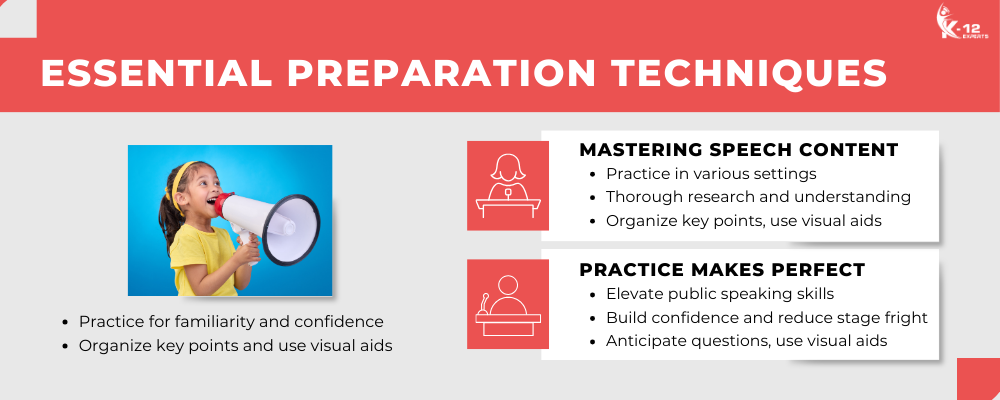Conquering stage fright means stepping into your power as a young orator, understanding that the jittery feeling is a rite of passage, not a stop sign. First off, know you’re not alone in fearing the spotlight—it’s a common stage shared by many. Mastering your speech content front-to-back gives you a solid foundation, while repeated practice transforms nerves into confidence. Mental tricks like visualizing success, staying present, and deep breathing are your backstage passes to calmness. Embrace the experience, recognizing each presentation as a leap towards becoming the speaker you aspire to be.
Channel that nervous energy into your delivery; let it fuel, not freeze you. With each step you take, from preparing meticulously to embracing the journey, you edge closer to turning stage fright into your personal highlight. Keep moving forward, and you’ll uncover even more ways to shine in the spotlight.
Understanding Stage Fright

Stage fright, a common fear among many American adults, often stems from a deep-seated fear of negative evaluation. You’re not alone if the mere thought of public speaking sends your heart racing.
This fear of public speaking can evolve into performance anxiety, making it difficult to express your thoughts clearly when all eyes are on you. But here’s the good news: you can conquer stage fright.
Understanding that this fear largely comes from worrying about others’ opinions and the intense pressure to perform well is the first step. Remember, most people suffer from this anxiety in silence, thinking they’re the only ones.
Knowing you’re part of a larger community facing the same challenge can be incredibly reassuring and the first stride towards overcoming your fear.
Essential Preparation Techniques

Moving on to essential preparation techniques, remember that mastering your speech content is your first step toward a confident delivery. Practicing repeatedly not only makes you familiar with your material but also helps perfect your performance, ensuring you’re ready for any curveballs.
This foundation allows you to engage your audience with ease and showcase your knowledge, making each practice session a stepping stone to your success as a speaker.
Mastering Speech Content
Why is mastering your speech content essential?
Well, imagine speaking in front of an enthusiastic audience, your fear dissipating because you’ve got this. It’s all about practicing in front of the mirror, your pet, or even a video camera to guarantee you’re on top of your game. Thorough research and understanding of your topic lay the foundation.
Organizing key points and creating a clear structure make your speech not just a talk but a journey for your listeners. Incorporating visual aids and props can turn a monologue into an engaging story.
And let’s not forget rehearsing potential Q&As; being prepared for unexpected questions makes you unshakable. It’s your armor against stage fright, making you ready to conquer.
Practice Makes Perfect
To elevate your public speaking skills, diligent practice is imperative. It’s the cornerstone for mastering your delivery and overcoming stage fright. Rehearsing your speech multiple times not only builds confidence but also makes you familiar with your material, reducing those butterflies in your stomach.
Don’t forget to take deep breaths; it’s a simple yet effective technique to maintain your calm. Familiarize yourself with the venue and anticipate potential questions. This preparation guarantees you’re not caught off-guard.
Using visual aids can also greatly support and enhance your points, making your presentation more engaging. Remember, practice doesn’t just make perfect; it makes you poised, prepared, and powerful in front of any audience.
Mental Strategies for Confidence
How can you boost your confidence before stepping onto the stage? Successful public speaking often hinges on not just what you say but how confidently you say it. Here are four mental strategies to help you stand tall and make eye contact with your audience:
- Visualize Success: Imagine yourself delivering a flawless speech and receiving applause. This can greatly enhance your confidence.
- Stay Present: Focus on your current sentence, not the next one, to keep distractions at bay.
- Practice Deep Breathing: Before you go on, take deep breaths to calm your nerves and steady your voice.
- Channel Nervous Energy: Use any jitters as fuel to energize your delivery rather than letting them derail you.
The Power of Practice
Building on the mental strategies that bolster confidence, practicing your speech repeatedly is another key step to mastering public speaking. By rehearsing multiple times, you’re not just getting familiar with your content; you’re building a solid foundation that makes every word feel like a trusted friend.

Public speaking classes often emphasize the importance of practice in conquering stage fright. It’s okay to make mistakes during these sessions because each error is a lesson learned, guiding you toward perfection. Using a camera to record your practice can reveal areas for improvement, while bullet lists keep your thoughts organized.
Consistent practice turns your speech into muscle memory, reducing the fear of forgetting and letting you focus on engaging your audience.
Using Visual Focus Points
Incorporating visual focus points into your speech can greatly enhance your connection with the audience. Here’s how:
- Use Visual Aids: Slides or props can highlight your main points, making your speech more engaging.
- Maintain Eye Contact: Connecting visually with your audience builds trust and keeps them interested.
- Employ Visual Cues: These can prompt you to remember your speech, reducing the chance of getting lost.
- Make It Dynamic: Adding visual elements keeps your presentation lively and memorable.
Visual aids, eye contact, and cues not only help you stay on track but also make your message resonate more deeply. So, let’s make your next speech not just heard but also seen and remembered!
The Art of Breathing
Mastering the art of breathing offers a powerful tool for young orators seeking to calm their nerves and enhance their vocal performance. Deep diaphragmatic breathing not only reduces anxiety before public speaking but also boosts vocal control and projection. By focusing on slow, intentional breaths, you can regulate your heart rate and promote a sense of relaxation.
Such breathing exercises enhance oxygen flow to your brain, sharpening focus and clarity. Practicing mindful breathing acts as a grounding technique, helping you stay present and composed on stage. Remember, integrating proper breathing techniques into your routine can transform your public speaking experience, turning jitters into poised confidence.
Structuring Your Speech

Now that you’ve mastered the art of breathing, it’s time to focus on how to structure your speech for the greatest impact.
You’ll start by crafting a strong opening that grabs your audience’s attention, then develop your core arguments with clarity and conviction.
Crafting a Strong Opening
To captivate your audience from the start, it’s crucial to create a strong opening that sets the tone for your speech. Stepping onto the stage, eye contact is your first ally in establishing a connection with your audience at the beginning of every speech.
Here’s how to make that happen:
- Start with a captivating hook, like a surprising fact or a story that grabs attention.
- Clearly state the purpose of your speech to provide your audience with a clear direction.
- Introduce yourself and explain why you’re the right person to discuss this topic, establishing credibility.
- Smoothly shift to your main points to maintain the flow and sustain audience interest.
Developing Core Arguments
After a captivating beginning, it’s time to concentrate on organizing your speech with strong core arguments that resonate with your audience.
As proficient public speakers understand, crafting core arguments with a clear structure enhances comprehension. Arrange your arguments logically, ensuring they’re coherent and convincing. Utilize supporting evidence and examples to strengthen your credibility.
Don’t overlook to integrate connections between your key points, ensuring your speech flows smoothly. It’s essential that each argument aligns with your main thesis, enhancing your speech’s overall effectiveness.
Effective Closing Techniques
Perfecting successful closing techniques guarantees your speech doesn’t just end but leaves a powerful, lasting impact on your audience. Here’s how to deliver a successful closing:
- Summarize Key Points: Remind your audience of the core arguments to strengthen your message.
- Reiterate Your Call to Action: Make it clear what you want your audience to do next.
- Use a Memorable Ending: Whether it’s a quote or a story, make it impactful.
- Pose a Question or Challenge: Encourage reflection and engagement.
Making eye contact as you conclude will help you feel more connected and confident. These steps ensure you not only deliver a successful speech but also leave your audience with something to remember.
Seeking Professional Guidance

Seeking guidance from licensed mental health professionals can be a game-changer for young orators struggling with stage fright. These experts provide personalized techniques, helping you tackle negative perceptions and manage fear effectively.
They’ll offer tips to help with making eye contact and maintaining the right mental attitude, which are essential skills for any speaker. Working with a professional, you can build confidence, develop empowering beliefs, and improve self-esteem.
This tailored strategy guarantees you’re not just coping with stage fright in the short term but conquering it for good. Remember, consulting with mental health experts is a step toward long-term solutions, giving you the tools and support to become a successful orator.
Embracing the Experience
Embracing stage fright, rather than shying away from it, can be your stepping stone to becoming a more confident and resilient orator. Here’s how you can transform nervousness into a powerful ally:
- Recognize Your Progress: Every time you face the fear of failure, you’re growing.
- Learn Coping Strategies: Techniques like deep breathing can calm your nerves.
- Connect With Your Audience: Making eye contact helps transform public speaking in front of a crowd into a conversation.
- Channel Nervous Energy: Use the adrenaline rush to bring enthusiasm to your speech.
Frequently Asked Questions
What Are the 6 Anxiety-Reducing Tips for Public Speaking?
To slay your public speaking dragon, start with breathing exercises, engage with your audience, and employ visualization techniques. Add meditation, swap negative thoughts for positive ones, and seek constructive feedback to conquer anxiety.
What Are the Six Steps to Conquer Stage Fright?
To conquer stage fright, you’ll need to focus on preparation strategies, confidence building, and audience engagement. Start by understanding your material inside out, then work on boosting your self-esteem and interacting with your audience effectively.
What Are the Tips Given by the Written to Overcome Stage Fright?
Ironically, you’ll conquer stage fright not by avoiding it but by facing it. Breathing exercises, visualization techniques, and confidence-building are key tips. They’ll help you feel safer and more empowered when speaking publicly.
How Do I Help My Child Overcome Stage Fright?
To help your child overcome stage fright, create a supportive environment with plenty of practice sessions. Use positive reinforcement to boost their confidence. Remember, your support is key in helping them feel secure and prepared.
Conclusion
Now, you’ve got the tools to tackle stage fright head-on. Remember, it’s about preparation, mental strategies, and practice.
Breathe deeply, find your focus points, and structure your speech. Don’t shy away from seeking professional guidance if you need it, but above all, embrace the experience.
The journey ahead might seem challenging, but with each step, you’re not just conquering fear; you’re transforming it into your greatest ally. The spotlight awaits, and it’s your time to shine. Will you step into it?




